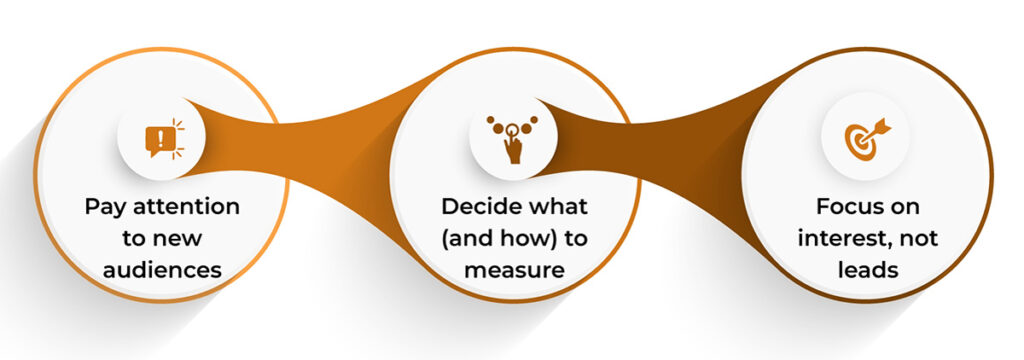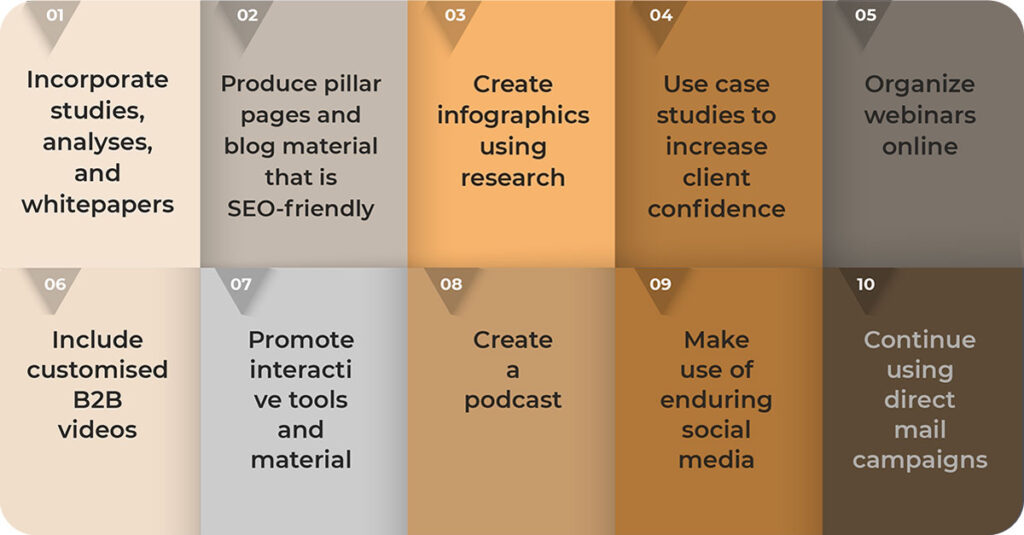
If marketing is a machine, leads—high-quality prospects who are interested in making a purchase—might be considered its primary output. However, it requires a power source to function, just like any other machine. B2B content is where that energy comes from.
Demand may be generated effectively through content. According to data from the Content Marketing Institute, in fact, 77% of B2B marketers said they have a content marketing plan in place for just this reason.
Sharing two straightforward ideas—that your audience has a problem and that your solution is the greatest fit—is the foundation of B2B content marketing for demand generation. By developing a positive cycle that increases demand, you may escape the vicious cycle of concentrating just on leads, depleting it, and turning to ever-more fierce lead generating techniques.
We’ve compiled the most recent data on which content marketing strategies create the greatest demand from top-performing B2B businesses in this blog. You’ll discover how to create demand-generating content and get advice on how to target fresh audiences and improve content. We’ll also discuss the facts on what is most effective in B2B now and in the next years.
Must Read: 9 demand generation books every marketer must need to know
How to Develop a Demand-Generating B2B Content Strategy
Table of Contents
- 1 How to Develop a Demand-Generating B2B Content Strategy
- 1.1 1. Pay Attention To New Audiences.
- 1.2 2. Decide What (and how) To Measure.
- 1.3 3. Focus On Interest, Not Leads.
- 1.4 B2B Content Ideas to Boost Demand
- 1.4.1 1. Incorporate Studies, Analyses, And Whitepapers.
- 1.4.2 2. Produce Pillar Pages And Blog Material That Is SEO-Friendly.
- 1.4.3 3. Create Infographics Using Research.
- 1.4.4 4. Use Case Studies To Increase Client Confidence
- 1.4.5 5. Organize Webinars Online.
- 1.4.6 6. Include Customized B2B Videos.
- 1.4.7 7.Promote Interactive Tools And Material.
- 1.4.8 8. Create A Podcast.
- 1.4.9 9. Make Use Of Enduring Social Media.
- 1.4.10 10. Continue Using Direct Mail Campaigns.
- 1.5 Share this:
Do you want to learn how to create demand through B2B content marketing?
To create a successful content strategy, start with the following guiding principles:

1. Pay Attention To New Audiences.
You must employ several avenues in order to reach new audiences. Consider where your audience is, get in touch with them, and engage them in conversation to create a natural and organic community.
Demand generation may face a challenge—and an opportunity—in identifying that target population. Although it’s virtually difficult to predict which customer interactions consumers may have today will result in a purchase in the months or even years to come, this offers up a world of experimentation.
Must Read: B2B Demand Generation Strategies in 2024
2. Decide What (and how) To Measure.
What we are tracking is no longer the question; rather, it is which tracks we are focusing on. And the indicators you pay attention to can make the difference between a successful and unsuccessful digital marketing plan.
What should we thus measure?
If you solely pay attention to backend analytics, you’re flying blind, claims Gaetano DiNardi, Head of Growth at Aura. For each marketing resource, you need to comprehend specific data on average sale size, lifetime value, and profitability. This enables you to choose the sources of the finest leads and low-cost methods for acquiring additional information.
But metrics are not always a perfect solution. Even “some of the finest marketing initiatives are not trackable,” according to DiNardi, who co-hosts the podcast State of Demand 2022 with Chris Walker of Refine Labs.
3. Focus On Interest, Not Leads.
The difficulty with lead generation content assets, like closed material or sales-driven content, is that they don’t educate customers who don’t know an issue persists. To inform customers about issues they are unaware of, demand generation combines instruction and brand storytelling.
Simply stated, successful marketers use content marketing to build demand from new and undiscovered audiences—not merely to identify demand that already exists, according to Robert Rose of the Content Marketing Institute.
Excellent demand generating content avoids making a sale. It presents an issue that your audience must deal with and explains why it is important enough for them to invest in your solution.
Even so, how can you utilize content marketing to reach your goals even if you have the correct demand gen marketing focus?
B2B Content Ideas to Boost Demand
It’s crucial to produce a variety of content formats for your marketing initiatives. Don’t limit your attention to one kind of content: Try out or even scale up blog entries, podcasts, in-depth how-to guides, videos, and other content that addresses consumer problem areas. To get you started, consider these top content ideas:

1. Incorporate Studies, Analyses, And Whitepapers.
Strong content pieces that offer you credibility and foster a relationship with a potential customer include original studies, surveys, and statistics.
For instance, at Nextiva, they recently released their research in a study on call centre analytics, which had a dramatic impact on overall SEO and established them as a thought leader in the field.
2. Produce Pillar Pages And Blog Material That Is SEO-Friendly.
If you know how to produce it, organic traffic has the potential to be one of the finest sources for creating demand.
The key is to consistently publish material that complies with excellent SEO principles. Although it will take time, in the long run, it can produce significant effects. And unlike bought advertisements, organic traffic helps you grow your own following.
3. Create Infographics Using Research.
According to Marketing Charts, with the greatest efficacy at this point, infographics are the second most successful sort of top-of-the-funnel content in the B2B market:
Try converting your original findings from reports or surveys into infographics or timeline graphs to reach a broader audience. It’s an excellent method for converting material to a new format without conducting further research.
4. Use Case Studies To Increase Client Confidence
Any B2B transaction is built on trust. How can a business be certain that your solution will perform as promised?
The best approach to explain this is through a case study. The solution is through the experience of other customers. Case studies may also be simply modified to fit varied circumstances. They may be posted on your website, sent to potential customers, and divided into smaller parts for social media.
5. Organize Webinars Online.
According to a recent marketing survey, webinars are among the best-performing assets for B2B:
There are certain advantages to webinars for demand generation. They work best in the middle of the sales funnel since they inform audiences about the issues your solution addresses. Webinars with an educational focus might be a terrific method to convert inactive visitors into quality leads.
Must Read: Top 6 Demand Generation Strategies Which Work!
6. Include Customized B2B Videos.
Today, one of the content kinds with the quickest growth is video. In actuality, 86% of companies utilise video as a marketing strategy nowadays. It’s time to start incorporating video content into your approach, if you haven’t already.
The most typical sorts of videos in the B2B marketing sector are how-to explainer videos, if that helps you decide where to start.
Although video marketing requires more resources than textual content, it is worthwhile. You may customize video for your blog, video platforms, social networking, and more. Video generates more engagement than material.
7.Promote Interactive Tools And Material.
To begin developing interactive sites and tools, you must go beyond your standard content. But you shouldn’t let it stop you.
Take into account choices that might benefit visitors and potential customers. An easy-to-create ROI calculator, for instance, might encourage your prospects to make a buy.
To increase traffic to your website, you may also take into account SEO-focused tools.
Must Read: 5 common demand generation plan problems to avoild
8. Create A Podcast.
Now is the moment to use audio marketing, if you haven’t already. There are three fundamental methods to enter the podcasting industry: You may buy advertisements to broadcast on podcasts that your audience listens to, host your own programme, or appear as a guest on other people’s shows.
In a market that will only get more competitive, podcasting now is where blogging was years ago—there is a significant first-mover advantage.
9. Make Use Of Enduring Social Media.
The majority of B2B social media marketing nowadays is concentrated on only one platform: LinkedIn.
Additionally, the kinds of material that succeed on LinkedIn are different from the short-form, sensational content that succeeds on other social media sites. Long-form, useful, or inspirational postings that inform or entertain are frequently preferred by LinkedIn users. These postings frequently remain online for several days or even weeks.
And this enduring social media material is rising in popularity. According to research from HubSpot, 44% of marketers intend to increase this type of “permanent” social media material, while 37% intend to reduce “ephemeral” content like articles.
If you know how to utilize it properly, social media has a lot to offer for B2B industry.
10. Continue Using Direct Mail Campaigns.
Not dead is physical mail. Due to its declining usage, it stands out among the B2B demand generating tools even more.
According to a study, 50% of B2B marketing executives continue to utilize direct mail for account-based marketing:
Direct mail might be the way to stand out if you’re seeking for a more distinctive strategy.
Conclusion: Use B2B Content To Create More Leads
You’ll soon start to suffer if you just concentrate your content marketing efforts on generating B2B leads. Instead, take into account a more well-rounded approach that involves creating demand by informing potential clients about the issue you address.
You’ll discover fresh and more effective methods to offer the sort of content that converts when you focus on meeting the requirements of your audience. As you pay attention to feedback and react to it, you’ll start a positive loop.
After all, how can your audience purchase your solution if they are unaware that they need it?
Must Read: Account Based Marketing – An Important Aspect Of Demand Generation Channel

Vikas Bhatt is the Co-Founder of ONLY B2B, a premium B2B lead generation company that specializes in helping businesses achieve their growth objectives through targeted marketing & sales campaigns. With 10+ years of experience in the industry, Vikas has a deep understanding of the challenges faced by businesses today and has developed a unique approach to lead generation that has helped clients across a range of industries around the globe. As a thought leader in the B2B marketing community, ONLY B2B specializes in demand generation, content syndication, database services and more.

.webp)
